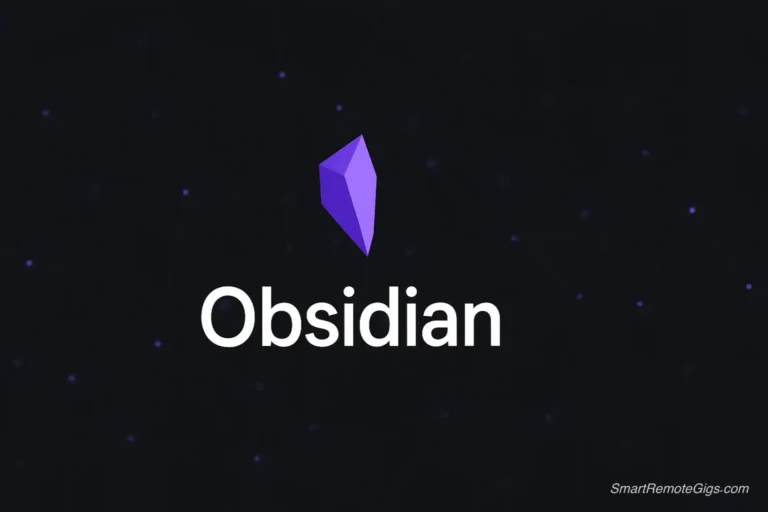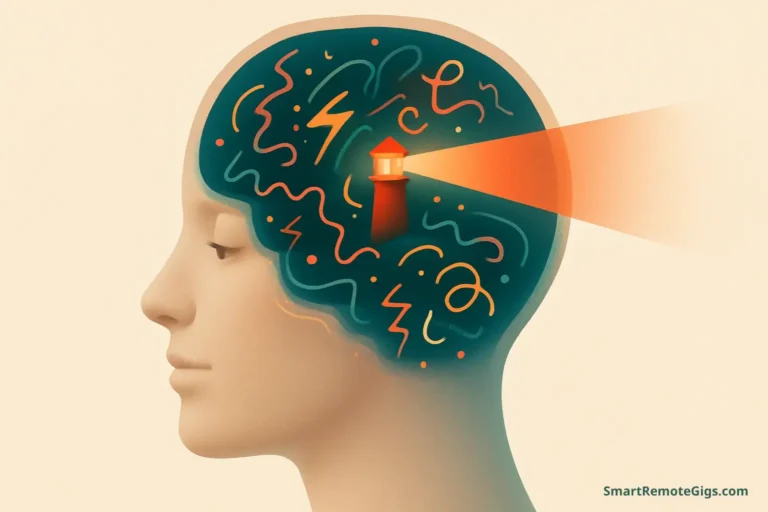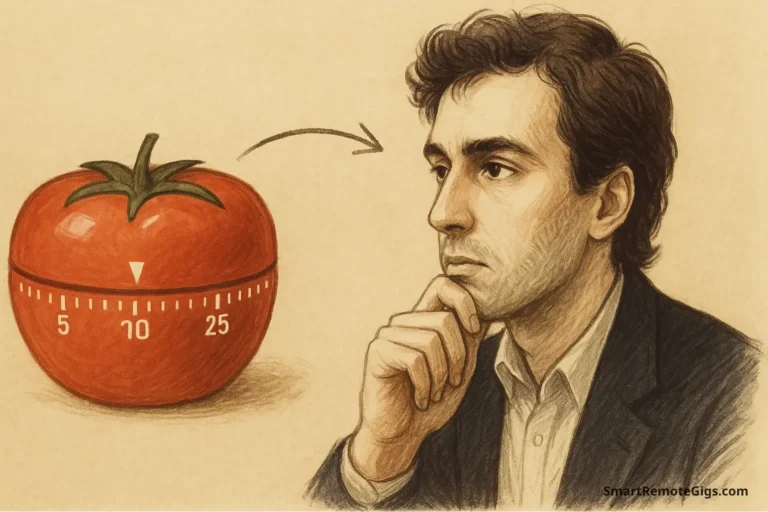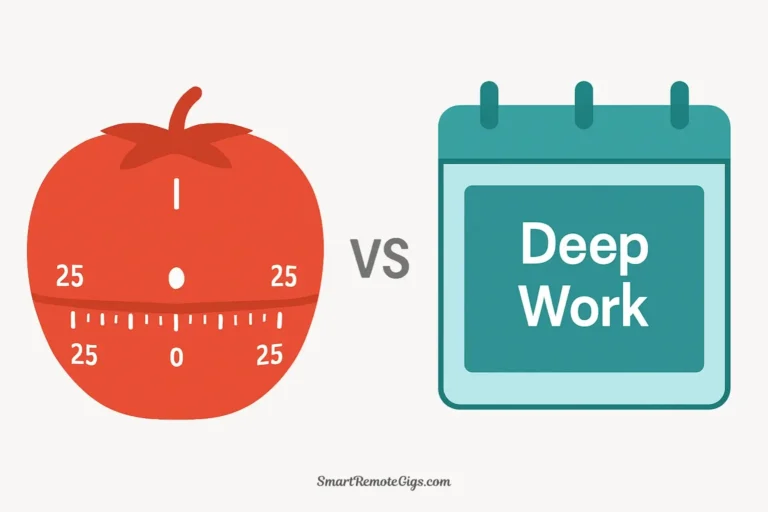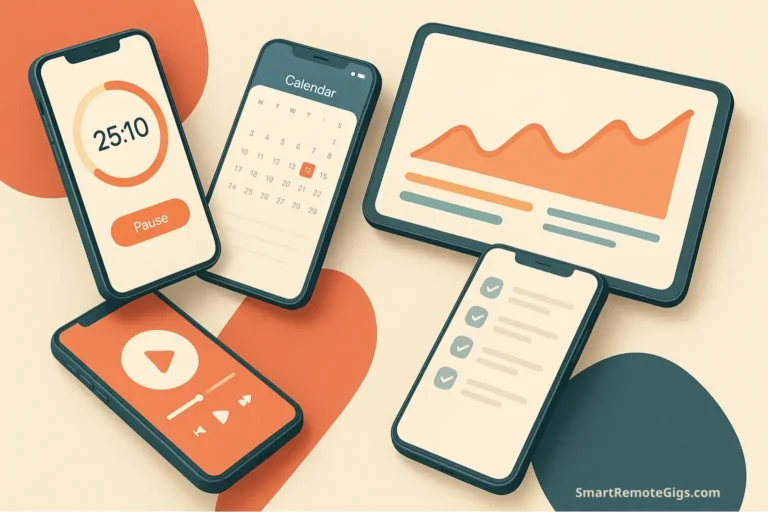You spend eight hours at your desk. You answer emails, work on a presentation, respond to Slack messages, join three meetings, update a spreadsheet, review a document, check social media “real quick,” and squeeze in some actual project work between interruptions.
At 5 PM, you’re mentally exhausted. Yet when you review what you accomplished, there’s almost nothing meaningful to show for it. The presentation is half-finished. The project barely moved forward. Your inbox is still overflowing.
You worked hard all day. So why does it feel like you got nothing done?
The answer is context switching—the silent productivity killer that’s draining your focus, demolishing your efficiency, and leaving you exhausted without visible results. Understanding what context switching is and how to stop it might be the single most important productivity insight you’ll ever learn.
The Simple Definition Every Professional Should Know
Context switching is the mental process that occurs when you shift your attention from one task to another different type of task. It’s what happens in your brain when you jump from writing a report to answering an email to attending a meeting to updating a spreadsheet.
Here’s the critical distinction: Context switching isn’t just changing activities—it’s changing the type of mental work you’re doing. When you go from:
- Creative work (writing) → Administrative work (email) → Strategic work (planning)
- Deep focus (analysis) → Social interaction (meeting) → Routine tasks (data entry)
- One client’s project → Another client’s project → Internal company work
Your brain has to completely reconfigure itself each time. It’s not like walking from one room to another—it’s like switching from playing piano to solving calculus to having a conversation in Spanish. Each requires a fundamentally different mental mode.
The False Promise of Multitasking:
Many people believe they’re “multitasking” when they rapidly switch between tasks. But neuroscience is clear: the human brain cannot actually multitask in the way we think it can. What we call multitasking is really just rapid context switching—and it comes with a devastating hidden cost.
The Science Behind the Switch: Why It Drains Your Brain
Context switching feels effortless in the moment. You see a notification, you check it. A colleague asks a question, you answer it. An idea pops into your head, you act on it. These switches feel like no big deal.
But your brain is paying a price you can’t see.
Research by Dr. Sophie Leroy, a business professor at the University of Washington Bothell who has spent over 17 years studying attention, reveals that the brain struggles to transition between tasks. When you switch from Task A to Task B, part of your attention often remains focused on Task A rather than fully transferring to Task B.
The Cognitive Switching Cost:
Every time you switch tasks, your brain must:
- Disengage from the current task’s mental framework
- Clear out the relevant information and rules from working memory
- Retrieve the new task’s context, goals, and relevant information
- Rebuild momentum and re-enter a focused state
- Overcome the startup inertia of beginning something new
This entire process takes time and mental energy—even if you’re not consciously aware of it happening. Studies consistently show that it can take 15-25 minutes to fully regain deep focus after a task switch, depending on the complexity of the tasks involved.
If you switch tasks 20 times in a workday, you’re paying this cognitive tax 20 times. Those switching costs add up to hours of lost productivity and significant mental fatigue.
Attention Residue: The Ghost of Your Last Task
The hidden mechanism that makes context switching so damaging is a phenomenon called attention residue.
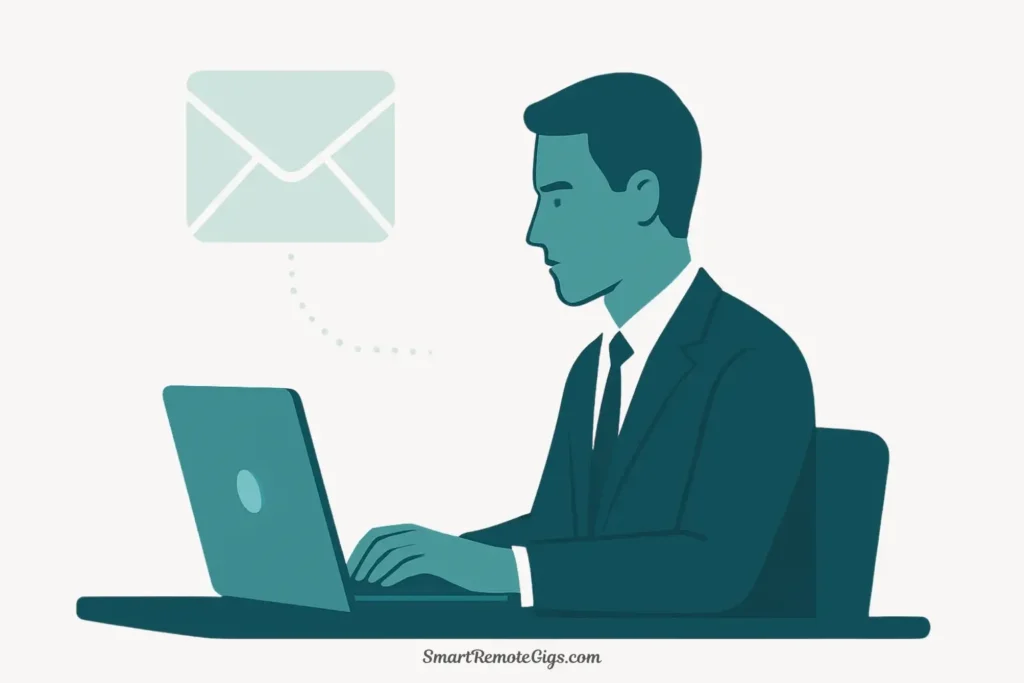
Dr. Leroy defines attention residue as what happens when “part of our attention is focused on another task instead of being fully devoted to the current task that needs to be performed”. In her groundbreaking research, she discovered that when you switch from one task to another, your mind doesn’t completely let go of the first task. Thoughts, concerns, and cognitive processes from the previous task continue running in the background—like apps left open on your phone, consuming processing power even when you’re not actively using them.
Attention residue easily occurs when tasks are left unfinished, when you’re interrupted, or when you anticipate having to rush through work later. Your brain finds it difficult to release these incomplete tasks and instead keeps them active in the background, even while you’re trying to focus on something else.
The Performance Impact:
When you experience attention residue from Task A while working on Task B, you have fewer cognitive resources available to perform Task B effectively. This means:
- Reduced ability to process information carefully
- Higher likelihood of missing important details or errors
- Slower completion times for tasks
- Lower quality output across all work
- Increased mental fatigue and stress
In Dr. Leroy’s experiments, participants who were told they would have limited time to complete an interrupted task experienced greater attention residue and performed significantly worse on their subsequent tasks compared to those who were promised adequate time.
Why Your Brain Can’t Let Go:
Attention residue occurs because humans have a fundamental psychological need for completion that makes switching attention difficult for the brain to execute. We naturally hold on to incomplete work instead of setting it aside, even when a switch of focus is necessary.
This explains why interruptions feel so disruptive and why you often find yourself thinking about previous tasks when you should be focused on current ones. Your brain is literally still processing information from work you were doing minutes or hours ago.
For a deeper understanding of how attention residue impacts your work, you can explore Dr. Leroy’s research on attention residue directly.
Three Real-World Examples of Context Switching in Action
Context switching is easiest to understand through concrete examples. Here’s what it looks like in typical work scenarios:
Example 1: The Fragmented Morning
Sarah is a marketing manager. Her morning looks like this:
- 9:00 AM: Starts writing a blog post (creative work)
- 9:15 AM: Email notification—responds to urgent client question (communication work)
- 9:25 AM: Returns to blog post, re-reads to remember where she was
- 9:35 AM: Slack message from boss—needs to pull Q3 data (analytical work)
- 9:50 AM: Joins unexpected Zoom call to troubleshoot campaign issue (problem-solving work)
- 10:20 AM: Returns to blog post—completely lost momentum, struggles to write
By 10:30 AM, Sarah has switched contexts six times. Each switch costs 5-10 minutes of transition time and leaves attention residue. What should have been 90 minutes of focused writing became 90 minutes of fragmented effort with minimal output.
Example 2: The Meeting Marathon
David is a consultant with back-to-back client meetings:
- 10:00 AM: Strategy meeting for Client A (tech startup)
- 11:00 AM: Immediately jumps to status call for Client B (healthcare company)
- 12:00 PM: Quick lunch while responding to emails
- 1:00 PM: Internal team meeting about new proposal (Client C)
- 2:00 PM: Problem-solving session for Client A (back to tech startup)
David struggles in each meeting to remember client context, previous discussions, and specific challenges. During one meeting, David realizes his brain was thinking about a completely different project, missing key information that was discussed. The constant switching between different client contexts and different types of work prevents him from showing up fully present and valuable in any single meeting.
Example 3: The “Just Checking” Trap
Lisa is a freelance designer working on a logo project:
- Deep in creative flow, designing variations
- Hears email notification—”just quickly checks”
- Sees message about a different client project—briefly thinks about that
- Remembers she needs to invoice someone—opens invoicing software
- Sees unread notification on social media—”just takes a peek”
- 20 minutes later, returns to logo design—creative flow completely destroyed
Lisa didn’t intend to take a 20-minute break. She intended to “quickly check” one email. But each small check created a new context switch, and each switch pulled her further away from the creative focus state she needs for design work.
These scenarios repeat countless times across millions of professionals every single day. The cumulative effect is staggering.
The True Cost: Quantifying Your Lost Time and Focus
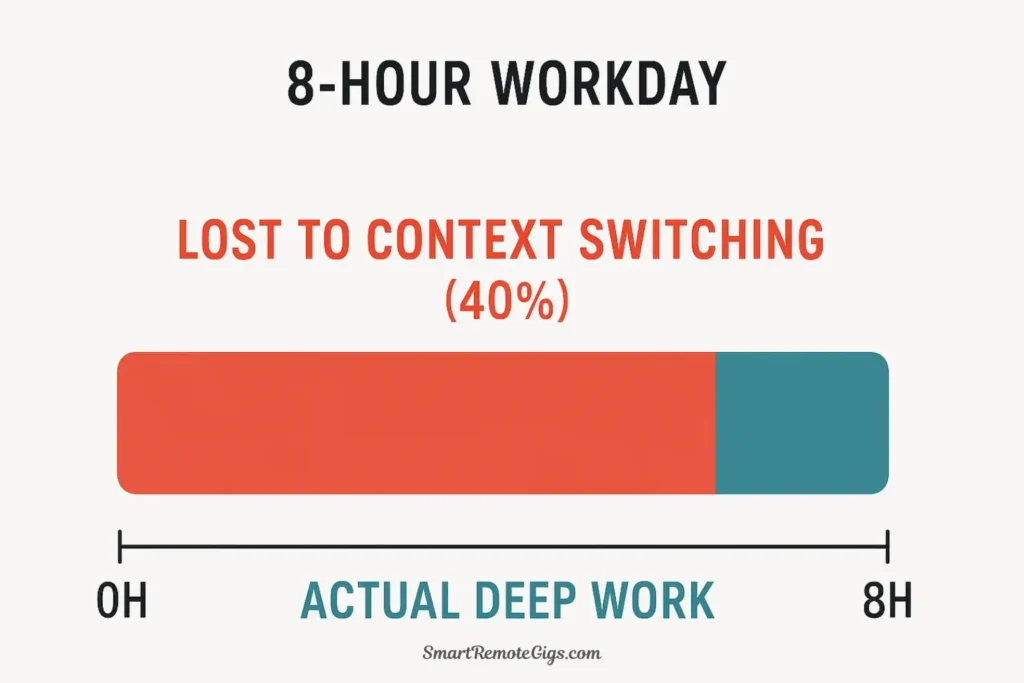
Context switching doesn’t just waste time—it compounds inefficiency in multiple ways:
Time Cost:
- Average time to regain focus after interruption: 15-25 minutes
- If interrupted 10 times per day: 2.5-4 hours of transition time lost
- Actual productive time: 4-5.5 hours out of an 8-hour workday
Quality Cost:
Research shows that people experiencing attention residue may not process information carefully and may miss information altogether. This means:
- More errors that require time to fix later
- Lower quality deliverables that don’t meet standards
- Important details overlooked in communications
- Strategic thinking replaced with reactive responses
Energy Cost:
Context switching is cognitively expensive. The more you switch, the faster your mental energy depletes:
- Increased mental fatigue by end of day
- Reduced decision-making capacity
- Higher stress and irritability
- Less creativity and problem-solving ability
- Greater likelihood of burnout over time
Opportunity Cost:
Time spent switching contexts is time not spent on:
- Deep, meaningful work that moves projects forward
- Strategic thinking and planning
- Skill development and learning
- Creative problem-solving and innovation
- Building relationships and meaningful connections
When you add it all up, context switching might be costing you 40-60% of your potential productivity. That’s not an exaggeration—it’s the reality documented by cognitive research.
How to Stop Context Switching: 3 Practical Strategies
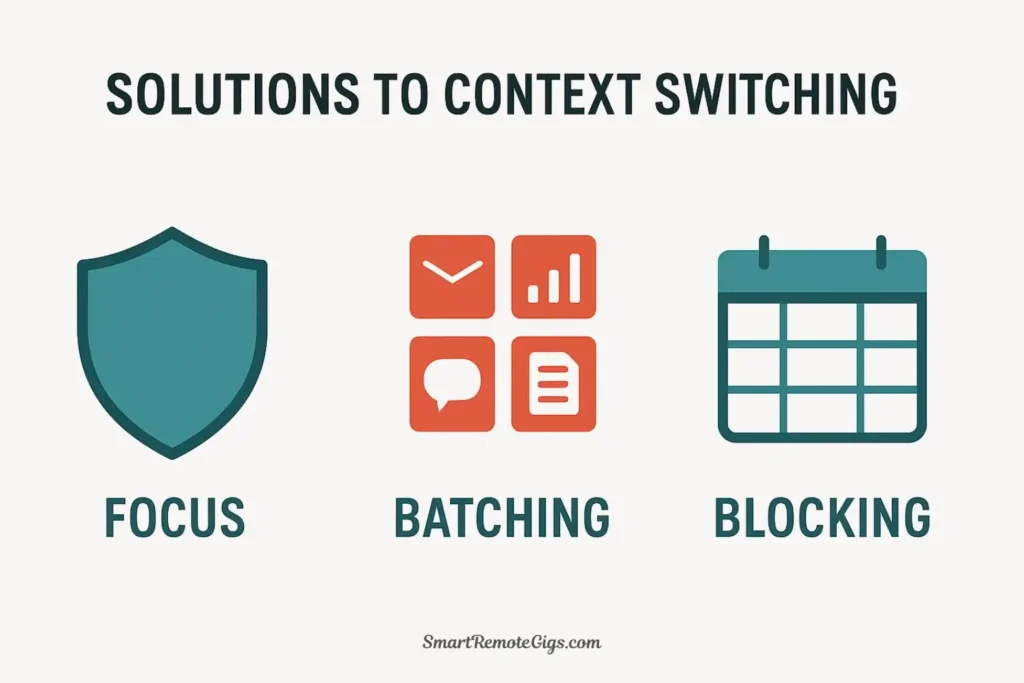
Understanding context switching is valuable, but stopping it is what transforms your productivity. Here are three proven strategies to reclaim your focus:
Strategy 1: The Power of Task Batching
What It Is: Task batching is the practice of grouping similar tasks together and completing them in dedicated time blocks. Instead of switching between different types of work throughout the day, you batch similar work together and knock it all out at once.
Why It Works: Batching eliminates context switching by keeping you in the same mental mode for an extended period. When you process all emails in one batch, write all content in another batch, and handle all client calls in a third batch, you never have to switch between different cognitive modes.
How to Implement:
- Identify recurring tasks that interrupt your day (email, calls, admin work, social media)
- Group similar tasks into categories (communications, creative work, administrative tasks)
- Schedule dedicated time blocks for each batch
- During each batch, only work on tasks from that category
Example: Instead of checking email 15 times throughout the day (15 context switches), check it twice in dedicated 30-minute batches—morning and afternoon. Process all emails during these windows, then close your email client completely.
For a complete, step-by-step system to implement task batching, see our detailed guide on how to task batch.
Strategy 2: Create a Distraction-Free Environment
What It Is: Intentionally designing your physical and digital workspace to minimize interruptions and eliminate triggers that cause context switches.
Why It Works: Many context switches are triggered by external cues—notifications, visual distractions, people walking by, tabs open in your browser. Removing these triggers prevents switches before they happen.
How to Implement:
Digital Environment:
- Turn off all non-critical notifications (email, Slack, social media)
- Close all browser tabs except those needed for current task
- Use website blockers during focus periods (Freedom, Cold Turkey)
- Put phone in another room or in airplane mode
- Use separate browser profiles for different work contexts
- Close email and messaging apps when doing deep work
Physical Environment:
- Use headphones as a “do not disturb” signal
- Face away from high-traffic areas if possible
- Clear desk of visual clutter and distractions
- Put a “Focus Time” sign on your door or desk
- Schedule focus blocks when office is quieter (early morning, late afternoon)
Social Boundaries:
- Communicate your focus schedule to team members
- Set expectations about response times
- Batch all meetings in specific time windows
- Use status indicators (Busy, Do Not Disturb) consistently
Strategy 3: Use Time Blocking to Protect Your Focus
What It Is: Time blocking is the practice of scheduling specific blocks of time for specific types of work. Instead of having a general “work day,” you create a structured calendar where each hour has a designated purpose.
Why It Works: Time blocking creates protective barriers around different types of work. When you know that 9-11 AM is “creative work only” and 3-4 PM is “email and communications,” you have permission to ignore everything that doesn’t fit the current block. This eliminates the decision fatigue and guilt that often leads to context switching.
How to Implement:
- Review your typical weekly tasks and responsibilities
- Identify your peak energy hours (usually morning for most people)
- Assign your most cognitively demanding work to peak hours
- Group similar work into consecutive blocks
- Include buffer time between major context shifts
- Schedule “catch-all” blocks for miscellaneous tasks and unexpected items
Sample Time-Blocked Day:
9:00-11:30 AM: Deep Work Block (project work, strategic thinking)
11:30-12:00 PM: Communications Batch (email, Slack, quick calls)
12:00-1:00 PM: Lunch + Walk
1:00-3:00 PM: Meetings Block (all meetings scheduled here)
3:00-4:00 PM: Administrative Batch (invoicing, filing, scheduling)
4:00-5:00 PM: Creative Work or LearningNotice how similar types of work are grouped together, and there are clear boundaries between different mental modes.
To understand the complete framework and how time blocking complements task batching, explore our comprehensive guide on time blocking vs task batching.
Conclusion: Reclaiming Your Attention Span
Context switching is invisible, which makes it dangerous. You don’t see the toll it takes in real-time. You just end each day feeling drained, wondering why you have so little to show for all your effort.
But now you know the truth: every time you switch between tasks, part of your attention remains stuck with the previous task, reducing your cognitive resources and performance on the current task.
The transformation from context-switching chaos to focused productivity looks like this:
Before Understanding Context Switching:
- Constant task-hopping throughout the day
- Feeling busy but accomplishing little
- Mental exhaustion by 3 PM
- Poor quality work with frequent errors
- Inability to enter deep focus states
- High stress and constant reactivity
After Eliminating Context Switching:
- Focused blocks of single-mode work
- Clear progress on important projects
- Sustained mental energy throughout the day
- Higher quality output with fewer mistakes
- Regular access to deep, creative flow states
- Calm, intentional approach to work
The choice is yours: continue operating in a constant state of partial attention, or implement systems that protect your focus and honor how your brain actually works.
Start with one strategy this week. Pick the one that addresses your biggest source of context switches:
- If notifications constantly interrupt you: Create a distraction-free environment
- If you jump between many small tasks: Implement task batching
- If your day lacks structure: Start time blocking
One strategy, consistently applied, will transform your workday. All three, working together, will transform your career and quality of life.
Context switching has been stealing your productivity. Now you know how to take it back.
Ready to implement the systems that eliminate context switching? Start with our complete guide on task batching or explore the strategic framework in time blocking vs task batching.
This article is part of our complete productivity framework designed to help you work smarter, not harder.

